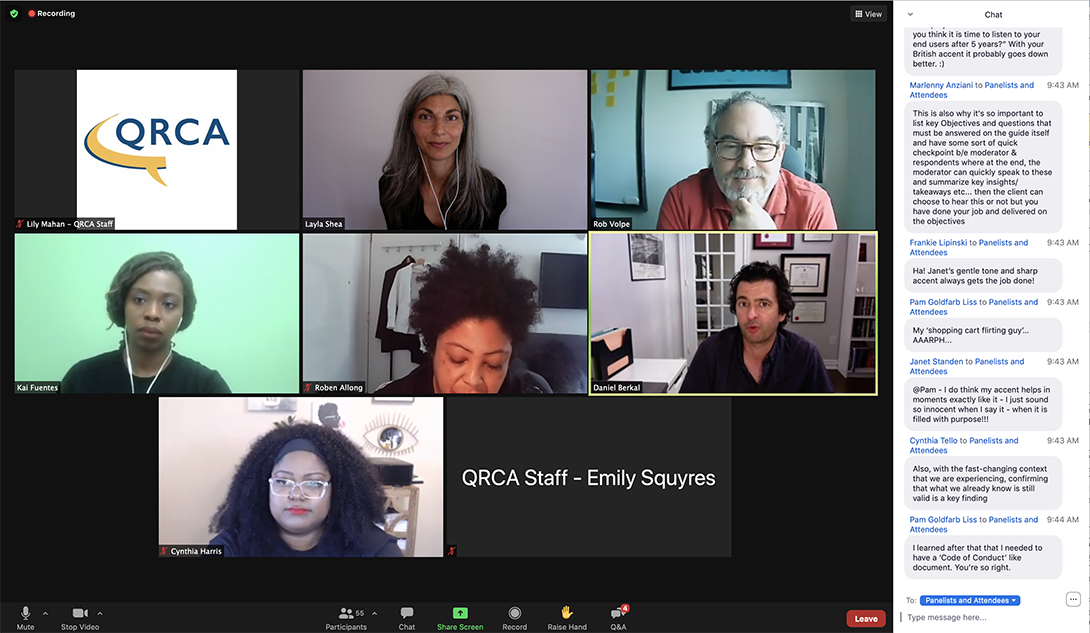Handling uncomfortable situations in qualitative research
Editor’s note: Layla Shea is the Founder and Chief Insights Officer at Upwords, a qualitative research consultancy. This is an edited version of a post that originally appeared under the title, “What would YOU do if…?”
After a recent in-depth interview Alex* (not their real name) felt very uncomfortable because the person being interviewed kept making racist remarks. The comments were not directed at them and were not related to the topic of discussion, but they still left Alex feeling uncomfortable. During the interview Alex let the interviewee speak and just listened, but afterward wondered if their silence might have signaled agreement. Should Alex have said how they really felt about it during the interview?
This is just one example of the many situations addressed by the diverse, expert panel of moderators during the QRCA’s webinar, “Uncomfortable situations I wish I knew how to deal with.” The panel included Cynthia Harris, Daniel Berkal, Kai Fuentes and Rob Volpe and was moderated by Layla Shea. Roben Allong hosted the event on behalf of QRCA’s Inclusive Culture Committee.
The panel addressed uncomfortable situations related to the following areas:
- Race/racism.
- Gender/sexuality.
- Culture.
- Stakeholder power struggles.

Yes, even trained moderators have different perspectives
Throughout the lively discussion (including “chat” from very engaged attendees), it became obvious that there are diverse opinions on how to handle different situations. We also realized we have different tolerances for what makes each of us uncomfortable. Part of the beauty of this discussion was the diversity of potential reactions, based on the panel members’ own lived experiences.
Understanding context
One key difference in how a moderator said they would respond was rooted in their assumptions around the context. For example, if a participant “accidentally” revealed during a webcam interview that they were only clothed on top, one panelist assumed that’s just how this person is most comfortable. “That’s part of the data set” was her response. She would quickly turn off the participant camera and ask them to let her know when they were covered up and ready to continue the interview. Others in this situation, assuming the participant meant to “show their parts,” might end the interview immediately.
Planning ahead
All panelists shared a similar perspective on the idea of planning ahead. There are always events that you can’t plan for (or couldn’t dream would happen… like a client flirting with a participant at a shop-along!), but some careful pre-planning can help mitigate many uncomfortable events from ever happening.
Steps to take before conducting human-to-human research
Here are some things you can do before conducting human-to-human research either online or in person:
- Set expectations.
- Send participants clear “ground rules” or expectations around the session. And yes, it’s OK to add “ensure you arrive fully clothed” and “be respectful of others” to the list of expectations!
- Provide clients a set of written expectations around their role and what is/is not appropriate. This includes considering each participant with respect and dignity.
- Prepare yourself by understanding the topic well, including any cultural or ethnic nuances that you may encounter given the participant specifications. Preparing yourself also means ensuring you deeply understand the client’s needs for the research and potential biases.
- Know your technology. Become confident in your abilities to quickly turn off a participant’s sound or video or removing them from a session altogether.
Steps to take during a session
No matter how well you plan, things will not always go according to plan. When something does make you uncomfortable, follow these guidelines from our experts:
- Remain neutral and provide unconditional positive regard for participants. Remarks from participants to the interviewer are part of the data set to be analyzed.
- Use the P.A.L.S. framework (pause, acknowledge, listen, speak) to diffuse the situation if remarks are disrespectful and directed toward you or others in a group setting.
- Take ownership of your mistakes and apologize. It helps others to see your human side.
- Show empathy toward a participant who becomes emotional – use softer tones, facial expressions, comforting words, and if appropriate, a simple touch on the arm or hand can go a long way to comforting someone.
Steps to take after a session
This is an important step that can really help a moderator to learn from their experiences – both positive and negative:
- Reflect on what went well and what did not. Consider how you might plan differently in the future based on something you learned. Is there anything you might do differently if in this situation next time?
- Use wellness tools to provide self-care. Each of us must absorb comments from participants that do not always align with our personal beliefs. It is our job to collect this as data that reflects the beliefs of our subjects. It is important to use breathing exercises and have a colleague, friends and/or family as a sounding board to help relieve stress.
Becoming confident in handling uncomfortable situations during human-to-human research
Let’s circle back to our original situation. Alex now appreciates the importance of “compartmentalizing” what they hear in an interview. Considering it to be the data and not in any way reflective of their personal beliefs will help relieve discomfort in this type of situation in the future.
Think about your own projects. What can you learn from uncomfortable situations you’ve been in? How might you plan differently in the future to avoid them – or if avoiding is not possible, how might you feel more confident in dealing with them in the future?
